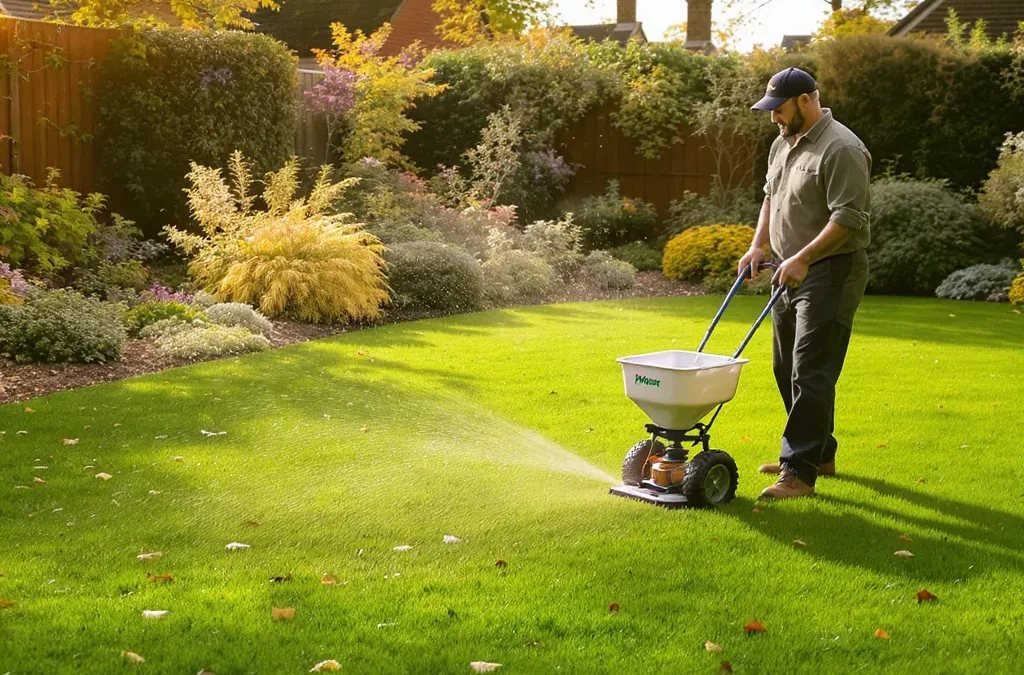If you want a lawn that stays lush, green, and healthy throughout the year, timing your feeding schedule is just as important as the type of fertiliser you use. In the UK, our temperate oceanic climate means grass growth patterns change dramatically with the seasons, and your lawn care routine needs to adapt accordingly. This guide walks you through a complete seasonal lawn feeding schedule for 2025, with practical tips for homeowners and property managers in West Sussex and beyond.
A well-fed lawn isn’t just about aesthetics — it’s about resilience. Feeding at the right times strengthens grass roots, helps resist pests and disease, and ensures your turf can handle everything from summer droughts to winter frosts.
Timing is everything in lawn feeding. In the UK, it’s not just about the season — it’s about soil temperature, moisture, and day length. Feeding too early or too late wastes product and can damage turf health.
— Dr. David Hedges-Gower
Understanding the UK Lawn Growth Cycle
The average UK lawn is around 160 m², and while that may not sound huge, even small lawns respond dramatically to seasonal changes. The UK growing season has lengthened by about two weeks over the last 30 years, according to the Met Office, due to warmer springs.
| Season | Months | Growth Pattern |
|---|---|---|
| Spring | March–May | Rapid growth as soil warms |
| Summer | June–August | Steady growth, possible stress in heat |
| Autumn | September–November | Root strengthening before dormancy |
| Winter | December–February | Minimal growth, rest period |
As shown above, the key to effective lawn feeding is to match the nutrient application to the plant’s natural growth phase.
Spring Feeding: Kickstarting Growth
Spring is the season where your lawn wakes up from winter dormancy. In West Sussex, you’ll typically see soil temperatures exceed 6°C by mid-to-late March — the perfect time for the first feed.
- March: Apply a high-nitrogen spring fertiliser to encourage strong green growth. Do this when daffodils are in bloom and the soil is consistently above 6°C.
- May: Follow up with a second spring feed to sustain growth and colour. If you have broadleaf weeds, consider a weed-and-feed product.
Summer Feeding: Sustaining Without Scorching
Summer brings steady growth, but also the risk of drought stress. In July, if your lawn starts to pale or thin, apply a light summer feed.
- Opt for a slow-release fertiliser to avoid scorching.
- Water in feeds during dry spells to prevent leaf burn.
- Avoid feeding during extreme heat or drought.
Autumn feeding is often overlooked, but it’s the single most important application for long-term lawn health, especially in wetter UK regions.
— Sarah Cook
Autumn Feeding: Preparing for Winter
Autumn is the most critical feeding time for long-term lawn health. From September to early November, focus on strengthening roots rather than top growth.
- September: Apply an autumn fertiliser higher in potassium and phosphorus. This will help harden the turf and improve disease resistance.
- November: If weather remains mild, a final feed can boost root reserves. Avoid high nitrogen at this stage.
| Nutrient | Spring Priority | Autumn Priority |
|---|---|---|
| Nitrogen (N) | High | Low |
| Phosphorus (P) | Medium | Medium-High |
| Potassium (K) | Medium | High |
This nutrient shift ensures your lawn is well-prepared to handle frost, heavy rain, and reduced sunlight.
Winter Care: Rest and Maintenance
From December to February, your lawn is dormant. Feeding during this time is unnecessary and can even harm the grass.
Instead:
- Service your mower and lawn tools.
- Conduct a soil analysis to check pH and nutrient levels.
- Plan your next year’s feeding schedule.
Climate and Regional Adjustments
The UK climate isn’t uniform — in Scotland, the first spring feed might be 2–3 weeks later than in southern England. Likewise, coastal areas like West Sussex may benefit from earlier feeding due to milder temperatures.
Climate change is also impacting schedules. Warmer springs and wetter autumns may extend feeding windows, but also increase disease risk.
Sustainable Lawn Feeding Practices
With more homeowners seeking eco-friendly options, consider these sustainable approaches:
- Use slow-release or organic fertilisers to reduce nutrient leaching.
- Avoid overfeeding to protect waterways.
- Combine feeding with scarification and aeration for better nutrient absorption.
Example Annual Schedule for West Sussex (2025)
| Month | Task | Product Type |
|---|---|---|
| January–February | No feeding; equipment maintenance | N/A |
| March | First spring feed | High-nitrogen fertiliser |
| May | Second spring feed; weed control if needed | Weed-and-feed |
| July | Light summer feed if stressed | Slow-release fertiliser |
| September | Autumn feed | High potassium/phosphorus fertiliser |
| November | Final mild-weather feed | Low-nitrogen autumn fertiliser |
This schedule is a baseline — always adjust based on weather, soil conditions, and lawn health.
Conclusion: Feeding for a Healthy, Resilient Lawn
A great lawn isn’t created overnight. By aligning your feeding schedule with your lawn’s natural growth cycle and local climate, you’ll encourage deeper roots, stronger turf, and a greener garden year-round.
In 2025, pay attention to soil temperatures, choose the right fertiliser for each season, and don’t overlook the importance of autumn feeding. Combine this with good mowing, aeration, and scarification practices, and your lawn will reward you with beauty and durability.
If you’re based in West Sussex and want a professional, tailored lawn care programme — from soil analysis to seasonal feeding — our expert team can help ensure your lawn thrives in every season.

